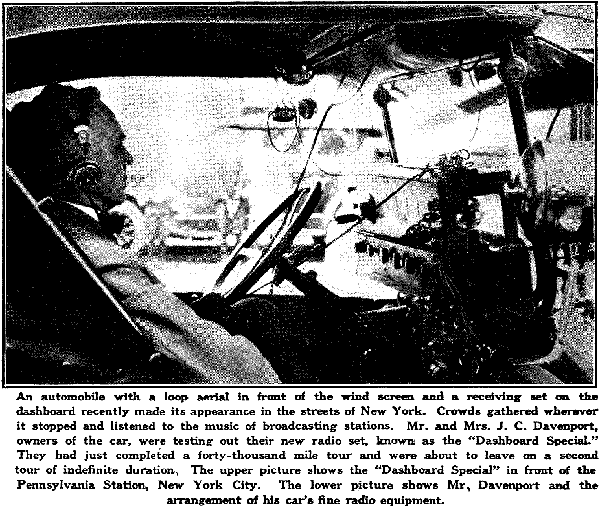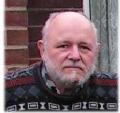First Car radios-history and development of early Car Radios
First Car radios-history and development of early Car Radios
History and development of early Car Radios
The very first broadcast receivers and early radios, that is to say sets of the early 1920s, almost always consisted of a box for the radio, one for the speaker and several batteries, sometimes in the form of accumulators containing liquid acids. Also required was a wire antenna of substantial length. All together, the components weighed a loaded suitcase. Nevertheless, one soon packed all into a wooden "suitcase" in order to be mobile.
Portable Radios as a Beginning
Attempts to integrate that new medium broadcasting into cars commenced quite early. As I described on page 56 of the book "Radios von gestern", portable radios and radios for use in an automobile were one and the same. An early example is the two-valve portable receiver by British Thomson-Houston that was displayed on January 29th, 1920, at the London Radio Exhibition. We should not forget that for other type of communication Lee DeForest did some demonstration with a car on the World Exhibition 1904 in St. Louis. But here we concentrate on published Broadcast programs which had begun at least in 1912 by Chales Herrold, San Jose and 1913 in Belgium.
Initially, it was portable battery radios that were individually adapted for installation into a car. The radio that George Frost, President of the "Lane High School Radio Clubs" in Chicago, had installed in his Ford-T-Model in 1922 is one of those receiving wider recognition. Another example, also dating back to 1922, is the "Marconiphone" radio installed in a "Daimler" that could be seen at the "Olympia Motorshow" in England. Some cities experimented with radio receivers in early patrol cars in an attempt to reach officers wirelessly. Also for military pourposes car radio was an issue. You will see in the attachments how transmission was done. On the same page of "Radio World" from 28th October 1922 there are the two photos below with the title: "The Dashboard Special makes 40,000 Mile Tour, Equipped with Radio".


There are more examples from that time period, especially from the mid-1920s. However, none of the radios such employed was specifically designed for use in an automobile. "Car Radios" as such came into use in the U.S. and in Europe around the same time; though the credit for having created the first product worthy of being called a car radio must go to the U.S.
First real Car Radios mass-produced
Based on the "Radio Collector's Guide 1921-32", we carry the Airtone 3D by "Radio Auto Distributors" for 1925 as a production model. There is also the Batt. 115-1926 by the All American Mohawk Corp (Lyric) from 1926. It must be said that I do have my doubts about both accounts in respect of the exact year.

It can justifiably be argued that these and the "Transitone" (not TH-1 !) from 1927 are the first mass-produced car radios. The year and date for the first production run of a "real car radio" remains still a bit of a mystery considering what's known about the subject at this time. However, it's safe to claim that the product "car radio" came into existence latest in 1927. See also the patent of William M. Heina from 1926 / 1927 on the Transitone page.
Confusion - no reliable statement of facts at this time
I would be reluctant to let myself be guided by the principle of "often repeated - it has to be right" and in this case declare the Transitone as the first car radio manufactured in mass production. All the facts are not yet in. Even less supportable is the assertion that the Transitone was made by Philco or is in any other way connected with Philco as one so often reads.
By the way: Philco actually stands for "Philadelphia Storage Battery Company", Philadelphia. Helios Corp. is possibly involved in all that as well. Philco bought the Automobile Radio Corp. (ARC), presumably to get a hold of their product "car radio". This only happened, however, in 1930. It would come closer to reality if ARC (see 109A Transitone), or according to other sources, Simplex (SRC) would be named as the manufacturer. The car radio Transitone has two control, or operating elements respectively, which didn't exactly facilitate its installation. Latest as of August 1930, Philco built the car radios for ARC and also sold them under their own brand name Philco. TH-3 is said to correspond to the Philco 38-12CB of 1938. Another claim made is: Model 3 = 1931. Philco used the brand transitione only a few times - up to 1934.
Major Manufacturers in 1929
Delco Radio Corp. (appliance) comes out with another early car radio, the Automotive 3002 of 1929. Not to be left behind, the "Delco-Remy Division" of General Motors introduces 1929 the model Cadillac LaSalle (as per Radio Collector's Guide 1921-32, which is not always very accurate). The Midwest Radio Co. offers the same year an eight-tube-TRF as a car radio, Silver-Marshall Manufacturing Co. brings out the car radio Auto 770. As this particular Collector's Guide is not very reliable, specific research into early car radios should be encouraged.
Which US-member will add pictures or data to existing early car radios - or upload new models for not yet listed car radios?
According to Rider's, there is around 1929 the "Police Automobile Radio AR-50" (AR50) by Sparks-Whitington Co. (Sparton). Konrad Birkner drew my attention to a statement made in the Radio News of July 1929: "Police Radio has passed its experimental state and has become an integral part of modern police equipment". It was, of course, still a one-way communication system.
It may be assumed that early car radios, until 1930, were always "straight" TRF receivers. That's based on a claim by "Scott Radio Labs" as published in the "Citizen Radio Callbook" of September 1930. There, they assert that with the Automobile Radio they brought out the first mass-produced superhet car radio.
Early receivers for use in an automobile were called car radio, motor radio, automotive radio, motor car radio, auto radio, etc. Power for the filament heating was usually taken from the accumulator (car battery); anodes were fed from dry cells. Incidentally, a problem of these set-ups was that the then customary 6-Volt systems were quickly discharged unless the engine was running (at the minimum required rpm).
1930 - a First Heyday for Car Radios
Early manufacturers in the USA include among others Advance Electric Co., with its "Auto Radio", Allied Radio Corp. with the Roamer A-S-30-SG, Atwater Kent (1931) with MotorCar Radio 81-B, 81-C and the 91 series, Automatic Radio Mfg. Co. (1930) with Senior 224 and Junior, Automobile Radio Corp. (1930) with 109A Transitone, Carteret Radio Labs, Moto Radio, Hyatt Electric Corp. M5, Roth-Downs Manufacturing Co. "Caradio", Fred W. Stein 130A.
The USA experience their the first "golden age" for car radios in 1930. You may also wish to refer here to United American Bosch, a subsidiary of Bosch, Germany, which likewise introduced in 1930 a car radio known as the "Motor Car Receiver 80" - with no effect on the European market. This information is included in Rider's, Volume 1, of 1930. It's not inconceivable, therefore, that the radio is a 1929 model.
The links I put in are for radios up to 1930 as listed at radiomuseum.org. Much data is still missing - we just don't have sufficient documentation on the subject. More research is required. Again: Who will dedicate him-/ herself to the task?
Shape and Power Supply
Car radios from the late 1920s and into the early 1930s feature almost all the same appearance characteristics: A fair-sized tin box (shielding) which contains the receiver, a speaker and sometimes the power supply plus a control element that is connected to the radio portion via a flexible shaft. As shown on the example of the Crosley Roamio 91, there was also the odd case where the speaker was mounted directly on the receiver box.

As initially the car battery was used to only heat the tube filaments, there had to be another box to accommodate the dry cells for the anodes. That arrangement was soon replaced by generators (Dynamotor, Macmotor), followed by power packs with vibrators and rectifiers. Then came synchro-vibrators with self-rectifying properties that made rectifiers redundant. All these components interfered with radio reception which in turn necessitated specific measures to counter that effect.
Tubes specifically designed for Car Radios (and other applications)
"Delco Radio Corp." followed up on its 1929 model with the superhet Model 3026 in 1931. That set used newly introduced tubes such as the 236, or 36 respectively and the 237, or 37 respectively for battery and mains operation (6.3-Volt heating element). These later evolve into types 4053 and 4053A.
Please note that in the USA, pentodes appear only from July 1931 onwards, even though Philips makes this type of tube as early as 1927. "National Union" introduces in May 1931 an entire series of tubes for car radios with 0.4-A heating. These include the NY64, NY65, NY67 and NY68. In July of the same year follow Arcturus, Raytheon and Ken-Rad with the 0.3-A types 236 (36), 237 (37), 238 (38) and 239 (39). RCA and Sylvania are not far behind with their offerings. The superhet concept prevails over previous designs by 1932. That applies simultaneously to both home and car radios.
Into the line-up of early "car radio tubes" belongs the above mentioned type 39 (239) which came out in February of 1932. The 44 (later combined as 39/44) appeared in April of that year, and in the fall of 1932 the A.F. tubes 85 and the output tube 41 became available.
Europe takes until 1934 to produce tubes which are configured to be heated via car battery as well as by a transformer. After some tests with Cupra Tubes the E-series for 6.3 Volt and the C-series for 12.6 Volt made their way to market in 1934. The latter ones predominantly for all-mains use.
Early car radios outside the USA
In Canada, the "Canadian General Electric Co. Ltd." brings in 1932 the M-30 to market. Germany has in 1932 with the Blaupunkt Autoradio AS5 its first car radio (see pictures). A comparison with the U.S.: By 1932 there are more than 100 car radio models available in the USA; it is further claimed that in 1933 there were already 100,000 car radios installed.
In Austria, Hornyphone follows up with its own Autoradio in 1934. For more information, take a look at the pictures of the octode-super contributed by Gerhard Heigl. During the same year, Philips introduces the car radios 241B and 243B in the Netherlands, in Germany and in Switzerland. Earliest for 1935, we have documented car radio production in France (Ducretet) and in Italy (Allocchio). Notwithstanding all this information, I am of the opinion that we are still far from having a complete record of all early car radios.
Without me asking, Alfred Zeeb, a member from Canada, made this translation of my article in German where also has been added a few more pictures. Thank you fro your great contribution, Alfred! I hope I did not spoil it by a few alterations/addings.
Every contribution about car radios is welcome. I hope this is a start for getting more information to models including pictures.
Added 2008 + April 30, 201221. by EE: Information about "Radio World" 1922 and broadcast 1912/1913 plus details about Transitone.
Attachments:- Car_Radio_1922_Radio_World1 (170 KB)
To thank the Author because you find the post helpful or well done.
More pictures
Michael Lamm, Publisher, Lamm-Morada Inc., California, USA, has sent some paper clips about car radios to me. He gave me the permission to scan and publish them. Here I can present one of those - maybe some other later or in an other form (size). Thank you, Michael, for this very kind offer as a guest.
To thank the Author because you find the post helpful or well done.
history of car radios

To thank the Author because you find the post helpful or well done.
British car radios

Hello everyone
As far as I can find, the first production to have a fitted radio in 1923 was the Springfield (USA) using a domestic radio that was adapted for a car.
The first purpose made car radio was Paul Galvin's Motorola in 1929, then the first English production car with a fitted radio was the Hillman Melody Minx in 1934.
To thank the Author because you find the post helpful or well done.
Early Car Radios

This "European" version was released in 1932. RadioRadio diplays in fig.282 (p.105) the installation of such a radio in a 1932 Vauxhall.
At that time an estimated 100,000 car radios were already in use in the USA.
To thank the Author because you find the post helpful or well done.
Some more pictures
You can find some more early pictures about car radios in the text in German.
To thank the Author because you find the post helpful or well done.
Early car radios in Italy

In Italy we had first examples in the early 30s from major makers of the time, although there was an early example already in 1928 made by Botner laboratories:

(Photo taken from "La Radio, storia di sessant'anni, 1924/1984", ERI/Edizioni RAI - thanks to Emilio Ciardiello)
In Radiomuseum, the earliest documented Italian car radios were Safar Autoradio (1933/34), Superla Autoradio (1934/35), Allocchio Bacchini Autonola I (1935), CGE B52 Auto (1935/36).
Interest in car radio has grown soon after, also thanks to the "Regio Automobil Club d'Italia" (Automobile club of Italian Monarchy, later called Automobil Club d'Italia - ACI, still existing nowadays). In 1937, the Automobile club issued a competition to choose the best autoradio, calling the major radio maker to show their production. Prize-winner of the contest was Magnadyne RACI, followed by Condor CR5, Irradio Autoradio and Sliar Savoia - as we show in this image (by courtesy of P.Giusti):

At that year, most of the main Italian makers had a car radio in their catalogue. Few companies, which were specialized in car radio, have been established in this period (like Condor and, later, Autovox)
According to another Italian article dated 1939, statistics from US Department of Agriculture were reporting 1.269.000 car radio being installed in American car.
To thank the Author because you find the post helpful or well done.
The Auto Radio: A Romantic Genealogy, Donald Matteson, 1987

This is still the most complete book on the subject. Don Matteson, who was curator of radio at the Henry Ford Museum, spent years collecting information and interviewing people, for this 298-page book. He has photos of the 1904 de Forest auto, Alfred Grebe's 1919 installation, the 1921 Detroit Police Dept. radio cruiser, and others. After 1930 he covers essentially every production model. He is careful not to take manufacturers' later claims at face value, so you won't find any "first production model" identified. Because it all depends on definitions, and no one knows how many were actually made by any of these companies.
To thank the Author because you find the post helpful or well done.
